Crystallization of Metallic Glasses and Supercooled Liquids
Abstract
:1. Introduction
2. Glass Formation from Liquids
3. Structural Relaxation and Phase Separation on Heating Prior to Crystallization
4. Crystal Nucleation and Initial Crystallization Stage
5. Growth of Crystals and Kinetics of Crystallization
6. Fast Primary Crystallization
7. Truly Eutectic Crystallization and Crystallization Looking like Eutectic
8. Fast Polymorphic Crystallization
9. Features of Crystallization during Welding and Additive Manufacturing
10. Mechanically Induced Crystallization at Room Temperature
11. Summary
Funding
Data Availability Statement
Conflicts of Interest
References
- Klement, W.; Willens, R.H.; Duwez, P. Non-crystalline Structure in Solidified Gold–Silicon Alloys. Nature 1967, 187, 869–870. [Google Scholar] [CrossRef]
- Chen, H.S. Glass temperature, formation and stability of Fe, Co, Ni, Pd and Pt based glasses. Acta Metall. 1974, 22, 1505. [Google Scholar] [CrossRef]
- Kui, H.W.; Greer, A.L.; Turnbull, D. Bulk formation of a metallic glass: Pd40Ni40P20. Appl. Phys. Lett. 1982, 45, 716–717. [Google Scholar] [CrossRef]
- Molokanov, V.; Chebotnikov, V. Glass forming ability, structure and properties of Ti and Zr-intermetallic compound based alloys. Key Eng. Mater. 1990, 40–41, 319–332. [Google Scholar] [CrossRef]
- Inoue, A.; Zhang, T.; Masumoto, T. Zr–Al–Ni Amorphous Alloys with High Glass Transition Temperature and Significant Supercooled Liquid Region. Mater. Trans. JIM 1990, 31, 177–183. [Google Scholar] [CrossRef]
- Inoue, A. Nanostructured and non-crystalline materials, bulk glass-forming metallic alloys: Science and technology. Mater. Trans. JIM 1995, 36, 866. [Google Scholar] [CrossRef]
- Johnson, W.L. Bulk Glass-forming metallic alloys: Science and technology. MRS Bull. 1999, 24, 42–56. [Google Scholar] [CrossRef]
- Inoue, A. Stabilization of metallic supercooled liquid and bulk amorphous alloys. Acta Mater. 2000, 48, 279–306. [Google Scholar] [CrossRef]
- Nagase, T.; Umakoshi, Y. Thermal crystallization and electron irradiation induced phase transformation behavior in Zr66.7Cu33.3 metallic glass. Mater. Trans. 2005, 46, 616–621. [Google Scholar] [CrossRef]
- Ojovan, M.I. The Flow of Glasses and Glass–Liquid Transition under Electron Irradiation. Int. J. Mol. Sci. 2023, 24, 12120. [Google Scholar] [CrossRef]
- Jiang, W.H.; Pinkerton, F.E.; Atzmon, M. Effect of strain rate on the formation of nanocrystallites in an Al-based amor-phous alloy during nanoindentation. J. Appl. Phys. 2003, 93, 9287–9290. [Google Scholar] [CrossRef]
- Ding, H.Y.; Yao, K.F. High entropy Ti20Zr20Cu20Ni20Be20 bulk metallic glass. J. Non-Crystalline Solids 2013, 364, 9–12. [Google Scholar] [CrossRef]
- Bykov, V.A.; Kovalenko, D.A.; Sterkhov, E.V.; Kulikova, T.V. Crystallization kinetics of GdYScAlCo high-entropy bulk metallic glass. Chim. Techno Acta 2023, 10, 202310207. [Google Scholar] [CrossRef]
- Luan, H.; Zhang, X.; Ding, H.; Zhang, F.; Luan, J.H.; Jiao, Z.B.; Yang, Y.-C.; Bu, H.; Wang, R.; Gu, J.; et al. High-entropy induced a glass-to-glass transition in a metallic glass. Nat. Commun. 2022, 13, 2183. [Google Scholar] [CrossRef]
- Makarov, A.S. General thermodynamic approach to describe the kinetics of thermal effects in high-entropy metallic glasses. JETP Lett. 2023, 118, 182–188. [Google Scholar] [CrossRef]
- Louzguine-Luzgin, D.V.; Zanaeva, E.N.; Pratama, F.R.; Wada, T.; Ito, S. Structural peculiarities of Pd-Cu-Ni-P and Pt-Cu-Ni-P metallic glasses as a reason for their significantly different room-temperature plasticity. Scr. Mater. 2023, 231, 115468. [Google Scholar] [CrossRef]
- Madge, S.V. Toughness of bulk metallic glasses. Metals 2015, 5, 1279–1305. [Google Scholar] [CrossRef]
- Chen, H.S.; Turnbull, D. Evidence of a glass–liquid transition in a gold–germanium–silicon alloy. J. Chem. Phys. 1968, 48, 2560. [Google Scholar] [CrossRef]
- Sanditov, D.S.; Ojovan, M.I. On relaxation nature of glass transition in amorphous materials. Phys. B Condens. Matter 2017, 523, 96–113. [Google Scholar] [CrossRef]
- Cohen, M.H.; Grest, G.S. Liquid-glass transition, a free-volume approach. Phys. Rev. 1979, 20, 1077. [Google Scholar] [CrossRef]
- Greer, A.L. New horizons for glass formation and stability. Nat. Mater. 2015, 14, 542–546. [Google Scholar] [CrossRef]
- Ojovan, M.I.; Tournier, R.F. On structural rearrangements near the glass transition temperature in amorphous silica. Materials 2021, 14, 5235. [Google Scholar] [CrossRef]
- Na, J.H.; Corona, S.L.; Hoff, A.; Johnson, W.L. Observation of an apparent first-order glass transition in ultrafragile Pt–Cu–P bulk metallic glasses. Proc. Natl. Acad. Sci. USA 2020, 117, 2779–2787. [Google Scholar] [CrossRef]
- Tournier, R.F.; Ojovan, M.I. Undercooled phase behind the glass phase with superheated medium-range order above glass transition temperature. Phys. B Condens. Matter 2021, 602, 412542. [Google Scholar] [CrossRef]
- Gale, W.F.; Totemeier, T.C. Smithells Metals Reference Book, 8th ed.; Elsevier Butterworth-Heinemann Ltd.: Oxford, UK, 2004. [Google Scholar]
- Ojovan, M.I. Viscous flow and the viscosity of melts and glasses. Phys. Chem. Glas. Eur. J. Glass Sci. Technol. Part B 2012, 53, 143–150. [Google Scholar]
- Louzguine-Luzgin, D.V. Structural changes in metallic glass-forming liquids on cooling and subsequent vitrification in relationship with their properties. Materials 2022, 15, 7285. [Google Scholar] [CrossRef]
- Kelton, K.F. A perspective on metallic liquids and glasses. J. Appl. Phys. 2023, 134, 010902. [Google Scholar] [CrossRef]
- Ojovan, M.I.; Louzguine-Luzgin, D.V. On crossover temperatures of viscous flow related to structural rearrangements in liquids. Materials 2024, 17, 1261. [Google Scholar] [CrossRef]
- Zhang, H.-R.; Gao, L.; Ye, Y.-H.; Zhang, J.-X.; Zhang, T.; Bu, Q.-Z.; Yang, Q.; Zhu, Z.-W.; Wei, S.; Yu, H.-B. Fragility crossover mediated by covalent-like electronic interactions in metallic liquids. Mater. Futur. 2024, 3, 025002. [Google Scholar] [CrossRef]
- Meyer, N.; Xu, H.; Wax, J.-F. Universality of the shear viscosity of alkali metals. Phys. Rev. B 2017, 96, 094201. [Google Scholar] [CrossRef]
- Qiao, J.C.; Wang, Q.; Pelletier, J.M.; Kato, H.; Casalini, R.; Crespo, D.; Pineda, E.; Yao, Y.; Yang, Y. Structural heterogeneities and mechanical behavior of amorphous alloys. Prog. Mater. Sci. 2019, 104, 250–329. [Google Scholar] [CrossRef]
- Yu, H.B.; Wang, W.H.; Bai, H.Y.; Samwer, K. The β relaxation in metallic glasses. Natl. Sci. Rev. 2014, 1, 429–461. [Google Scholar] [CrossRef]
- Zhang, L.; Wang, Y.; Yang, Y.; Qiao, J. Aging and rejuvenation during high-temperature deformation in a metallic glass. Sci. China Phys. Mech. Astron. 2022, 65, 106111. [Google Scholar] [CrossRef]
- Louzguine-Luzgin, D.V.; Jiang, J. Low-temperature relaxation behavior of a bulk metallic glass leading to improvement of both strength and plasticity. Mater. Sci. Eng. A 2022, 839, 142841. [Google Scholar] [CrossRef]
- Inoue, A.; Chen, S.; Masumoto, T. Zr-Y base amorphous alloys with two glass transitions and two supercooled liquid regions. Mater. Sci. Eng. A 1994, 179–180, 346–350. [Google Scholar] [CrossRef]
- Kündig, A.; Ohnuma, M.; Ping, D.; Ohkubo, T.; Hono, K. In situ formed two-phase metallic glass with surface fractal microstructure. Acta Mater. 2004, 52, 2441. [Google Scholar] [CrossRef]
- Louzguine-Luzgin, D.V.; Xie, G.; Zhang, W.; Inoue, A. Devitrification behavior and glass-forming ability of Cu–Zr–Ag alloys. Mater. Sci. Eng. A 2007, 465, 146–152. [Google Scholar] [CrossRef]
- Bazlov, A.I.; Parkhomenko, M.S.; Tabachkova, N.Y.; Igrevskaya, A.G.; Zanaeva, E.N.; Mamzurina, O.I.; Medvedeva, S.V.; Bazlova, T.A.; Louzguine-Luzgin, D.V. Formation of a phase separated structure in the Zr–Cu–Fe–Al alloys by thermo-mechanical processing. Intermetallics 2021, 35, 107224. [Google Scholar] [CrossRef]
- Louzguine-Luzgin, D.V.; Jiang, J.; Bazlov, A.I.; Zolotorevzky, V.S.; Mao, H.; Ivanov, Y.P.; Greer, A.L. Phase separation process preventing thermal embrittlement of a Zr-Cu-Fe-Al bulk metallic glass. Scr. Mater. 2019, 167, 31–36. [Google Scholar] [CrossRef]
- Bazlov, A.I.; Igrevskaya, A.G.; Tabachkova, N.Y.; Chen, C.; Cheverikin, V.V.; Pozdniakov, A.V.; Jiang, J.; Louzguine-Luzgin, D.V. Thermo-mechanical processing of a Zr62.5Cu22.5Fe5Al10 glassy alloy as a way to obtain tensile ductility. J. Alloys Compd. 2021, 853, 157138. [Google Scholar] [CrossRef]
- Pekarskaya, E.; Löffler, J.F.; Johnson, W.L. Microstructural studies of crystallization of a Zr-based bulk metallic glass. Acta Mater. 2003, 51, 4045–4057. [Google Scholar] [CrossRef]
- Louzguine-Luzgin, D.V.; Jiang, J. On Long-Term Stability of Metallic Glasses. Metals 2019, 9, 1076. [Google Scholar] [CrossRef]
- Zhao, Y.; Shang, B.; Zhang, B.; Tong, X.; Ke, H.; Bai, H.; Wang, W.H. Ultrastable metallic glass by room temperature aging. Sci. Adv. 2022, 8, 3623. [Google Scholar] [CrossRef] [PubMed]
- Kelton, K.F.; Greer, A.L. Nucleation in condensed matter applications in materials and biology. Pergamon Mater. Ser. 2010, 15, 1–743. [Google Scholar]
- Schmelzer, J.W.P.; Abyzov, A.S.; Baidakov, V.G. Time of formation of the first supercritical nucleus, time-lag, and the steady-state nucleation rate. Int. J. Appl. Glas. Sci. 2016, 8, 48–60. [Google Scholar] [CrossRef]
- Zhou, J.; Yang, Y.; Yang, Y.; Kim, D.S.; Yuan, A.; Tian, X.; Ophus, C.; Sun, F.; Schmid, A.; Nathanson, M.; et al. Observing crystal nucleation in four dimensions using atomic electron tomography. Nature 2019, 570, 500–503. [Google Scholar] [CrossRef] [PubMed]
- Schmelzer JW, P.; Tropin, T.V. Theory of crystal nucleation of glass-forming liquids: Some new developments. Int. J. Appl. Glass Sci. 2022, 13, 171–198. [Google Scholar] [CrossRef]
- Gasser, U.; Weeks, E.R.; Schofield, A.; Pusey, P.N.; Weitz, D.A. Real-space imaging of nucleation and growth in colloidal crystallization. Science 2001, 292, 258–262. [Google Scholar] [CrossRef] [PubMed]
- Louzguine-Luzgin, D.V.; Bazlov, A.I. Crystallization of FCC and BCC liquid metals studied by molecular dynamics simulation. Metals 2020, 10, 1532. [Google Scholar] [CrossRef]
- Hu, Y.C.; Tanaka, H. Physical origin of glass formation from multicomponent systems. Sci. Adv. 2020, 6, eabd2928. [Google Scholar] [CrossRef]
- Schmelzer, J.W.P.; Tipeev, A.O. Effect of planar interfaces on nucleation in melting and crystallization. Entropy 2022, 24, 1029. [Google Scholar] [CrossRef] [PubMed]
- Zheng, L.Q.; An, Q.; Xie, Y.; Sun, Z.H.; Luo, S.-N. Homogeneous nucleation and growth of melt in copper. J. Chem. Phys. 2007, 127, 164503. [Google Scholar] [CrossRef] [PubMed]
- Wang, C.E.L.; Cai, Y.; Wu, H.A.; Luo, S.N. Crystallization in supercooled liquid Cu: Homogeneous nucleation and growth. J. Chem. Phys. 2015, 142, 064704. [Google Scholar]
- Louzguine-Luzgin, D.V.; Miyama, M.; Nishio, K.; Tsarkov, A.A.; Greer, A.L. Vitrification and nanocrystallization of pure liquid Ni studied using molecular-dynamics simulation. J. Chem. Phys. 2019, 151, 124502. [Google Scholar] [CrossRef] [PubMed]
- Ashkenazy, Y.; Averback, R. Kinetic stages in the crystallization of deeply undercooled body-centered-cubic and face-centered-cubic metals. Acta Mater. 2010, 58, 524–530. [Google Scholar] [CrossRef]
- Wilde, G.; Sebright, J.L.; Perepezko, J.H. Bulk liquid undercooling and nucleation in gold. Acta Mater. 2006, 54, 4759–4769. [Google Scholar] [CrossRef]
- Bokeloh, J.; Wilde, G.; Rozas, R.; Benjamin, R.; Horbach, J. Nucleation barriers for the liquid-to-crystal transition in simple metals: Experiment vs. simulation. Eur. Phys. J. Spéc. Top. 2014, 223, 511–526. [Google Scholar] [CrossRef]
- Lu, A.K.A.; Louzguine-Luzgin, D.V. Crystal nucleation and growth processes in Cu-rich glass-forming Cu–Zr alloys. J. Chem. Phys. 2022, 157, 014506. [Google Scholar] [CrossRef] [PubMed]
- Wang, Z.; Chen, C.L.; Ketov, S.V.; Akagi, K.; Tsarkov, A.A.; Ikuhara, Y.; Louzguine-Luzgin, D.V. Local chemical ordering within the incubation period as a trigger for nanocrystallization of a highly supercooled Ti-based liquid. Mater. Des. 2018, 156, 504–513. [Google Scholar] [CrossRef]
- Louzguine, D.V.; Inoue, A. Nanoparticles with icosahedral symmetry in Cu-based bulk glass former induced by Pd addition. Scripta Mater. 2003, 48, 1325–1329. [Google Scholar] [CrossRef]
- Orava, J.; Greer, A.L.; Gholipour, B.; Hewak, D.W.; Smith, C.E. Characterization of supercooled liquid Ge2Sb2Te5 and its crystallization by ultrafast-heating calorimetry. Nat. Mater. 2012, 11, 279–283. [Google Scholar] [CrossRef] [PubMed]
- Zalden, P.; von Hoegen, A.; Landreman, P.; Wuttig, M.; Lindenberg, A.M. How supercooled liquid phase-change materials crystallize: Snapshots after femtosecond optical excitation. Chem. Mater. 2015, 27, 5641–5646. [Google Scholar] [CrossRef]
- Chen, N.; Gu, L.; Xie, G.Q.; Louzguine-Luzgin, D.V.A.R.; Yavari, A.; Vaughan, G.; Imhoff, S.; Perepezko, J.; Abe, T.; Inoue, A. Flux-induced structural modification and phase transformations in a Pd40Ni40Si4P16 bulk-glassy alloy. Acta Mater. 2010, 58, 5886–5897. [Google Scholar] [CrossRef]
- Cao, C.R.; Lu, Y.M.; Bai, H.Y.; Wang, W.H. High surface mobility and fast surface enhanced crystallization of metallic glass. Appl. Phys. Lett. 2015, 107, 141606. [Google Scholar] [CrossRef]
- Louzguine-Luzgin, D.V.; Kaloshkin, S.D.; Inoue, A. Peritectic-like reactions involving glassy phase. Rev. Adv. Mater. Sci. 2008, 18, 653–659. [Google Scholar]
- Kolmogorov, A.N. A statistical theory for the recrystallisation of metals. Isz. Akad. Nauk. USSR Ser. Matem. 1937, 3, 355–359. [Google Scholar]
- Johnson, M.W.A.; Mehl, K.F. Reaction kinetics in processes of nucleation and growth. Trans. Trans. Am. Inst. Min. Metall. Eng. 1939, 135, 416–442. [Google Scholar]
- Avrami, M. Granulation, phase change, and microstructure kinetics of phase change. III. J. Chem. Phys. 1941, 9, 177–184. [Google Scholar] [CrossRef]
- Louzguine-Luzgin, D.V.; Xie, G.; Zhang, W.; Inoue, A. Influence of Al and Ag on the devitrification behavior of a Cu-Zr glassy alloy. Mater. Trans. 2007, 48, 2128–2132. [Google Scholar] [CrossRef]
- Lan, S.; Wu, Z.D.; Wei, X.Y.; Zhou, J.; Lu, Z.P.; Neuefeind, J.; Wang, X.-L. Structure origin of a transition of classic-to-avalanche nucleation in Zr-Cu-Al bulk metallic glasses. Acta Mater. 2018, 149, 108–118. [Google Scholar] [CrossRef]
- Louzguine-Luzgin, D.V.; Yavari, A.R.; Vaughan, G.; Inoue, A. Clustered crystalline structures as glassy phase approximants. Intermetallics 2009, 17, 477–480. [Google Scholar] [CrossRef]
- Nishiyama, N.; Inoue, A. Supercooling investigation and critical cooling rate for glass formation in Pd–Cu–Ni–P alloy. Acta Mater. 1999, 47, 1487–1495. [Google Scholar] [CrossRef]
- Löffler, J.F.; Schroers, J.; Johnson, W.L. Time–temperature–transformation diagram and microstructures of bulk glass forming Pd40Cu30Ni10P20. Appl. Phys. Lett. 2000, 77, 681–683. [Google Scholar] [CrossRef]
- Janlewing, R.; Köster, U. Nucleation in crystallization of Zr–Cu–Ni–Al metallic glasses. Mater. Sci. Eng. A 2001, 304–306, 833–838. [Google Scholar] [CrossRef]
- Louzguine, D.V.; Inoue, A. Comparison of the long-term thermal stability of various metallic glasses under continuous heating. Scr. Mater. 2002, 47, 887–891. [Google Scholar] [CrossRef]
- Duan, T.; Kim, W.; Gao, M.; Perepezko, J.H. Crystallization of an undercooled Zn-based glass forming alloy. J. Non Crystalline Solids 2024, 627, 122823. [Google Scholar] [CrossRef]
- Grange, R.A.; Kiefer, J.M. Transformation of austenite on continuous cooling and its relation to transformation at constant temperature. Trans. ASM 1941, 29, 85–144. [Google Scholar]
- Wang, J.; Chen, N.; Liu, P.; Wang, Z.; Louzguine-Luzgin, D.; Chen, M.; Perepezko, J. The ultrastable kinetic behavior of an Au-based nanoglass. Acta Mater. 2014, 79, 30–36. [Google Scholar] [CrossRef]
- Luo, P.C.; Cao, R.; Zhu, F.; Lv, Y.M.; Liu, Y.H.; Wen, P.; Bai, H.Y.; Vaughan, G.; di Michiel, M.; Ruta, B.; et al. Ul-trastable metallic glasses formed on cold substrates. Nat. Commun. 2018, 9, 1389. [Google Scholar] [CrossRef]
- Yoshizawa, H.; Yamauchi, K.; Yamane, T.; Sugihara, H. Common mode choke cores using the new Fe-based alloys composed of ultrafine grain structure. J. Appl. Phys. 1988, 64, 6047–6049. [Google Scholar] [CrossRef]
- Suzuki, K.; Kataoka, N.; Inoue, A.; Makino, A.; Masumoto, T. High saturation magnetization and soft magnetic properties of bcc fe–zr–b alloys with ultrafine grain structure. Mater. Trans. JIM 1990, 31, 743–746. [Google Scholar] [CrossRef]
- Milkova, D.; Bazlov, A.; Zanaeva, E.; Churyumov, A.; Strochko, I.; Ubyivovk, E.; Inoue, A. (Fe-Ni)-based glassy alloy containing Nb and Cu with excellent soft magnetic properties. J. Non Crystalline Solids 2023, 609, 122234. [Google Scholar] [CrossRef]
- Wang, F.; Inoue, A.; Kong, F.L.; Han, Y.; Zhu, S.L.; Shalaan, E.; Al-Marouki, F. Formation, thermal stability and mechanical properties of high entropy (Fe,Co,Ni,Cr,Mo)-B amorphous alloys. J. Alloys Compd. 2018, 732, 637–645. [Google Scholar] [CrossRef]
- Shen, Y.; Perepezko, J.H. Al-based amorphous alloys: Glass-forming ability, crystallization behavior and effects of minor al-loying additions. J. Alloys Compd. 2017, 707, 3–11. [Google Scholar] [CrossRef]
- Abrosimova, G.; Matveev, D.; Pershina, E.; Aronin, A. Effect of treatment conditions on parameters of nanocrystalline structure in Al-based alloys. Mater. Lett. 2016, 183, 131–134. [Google Scholar] [CrossRef]
- Duan, T.; Shen, Y.; Imhoff, S.D.; Voyles, P.M.; Perepezko, J.H. Nucleation kinetics model for primary crystallization in Al-Y-Fe metallic glass. J. Chem. Phys. 2023, 158, 064504. [Google Scholar] [CrossRef] [PubMed]
- Abrosimova, G.; Aronin, A. On decomposition of amorphous phase in metallic glasses. Rev. Adv. Mater. Sci. 2017, 50, 55–61. [Google Scholar]
- Louzguine-Luzgin, D.V.; Inoue, A. Structure and transformation behaviour of a rapidly solidified Al–Y–Ni–Co–Pd alloy. J. Alloy Compd. 2005, 399, 78–85. [Google Scholar] [CrossRef]
- Zhang, Z.; Zhang, S.; Jing, Z.; Chen, C.; Liang, X. Effects of rare-earth element Y content on the microstructure and properties of quinary Al–Ni–Zr–Co–Y high entropy metallic glasses. Intermetallics 2024, 165, 108164. [Google Scholar] [CrossRef]
- Louzguine-Luzgin, D.V.; Pratama, F.R. In-situ studies of primary nucleation and growth of the cubic Al19Fe4MnSi2 phase in an Al–Fe–Mn–Si metallic glass. Intermetallics 2024, 164, 108120. [Google Scholar] [CrossRef]
- Tan, M.; Wang, J.; Wu, Y.; Jin, C.; Sun, Y.; Song, L.; Zhang, Y.; Wang, J.; Huo, J.; Gao, M. Accelerated crystallization kinetics and grain refinement in Mg-Ni-Y metallic glass via multiple rare earth elements doping. J. Alloys Compd. 2024, 999, 175080. [Google Scholar] [CrossRef]
- Ivanov Yu, P.; Semin, V.O.; Lu, Z.; Jiang, J.; Greer, A.L.; Louzguine-Luzgin, D.V. Long-range-diffusion-assisted but inter-face-controlled crystallization of a Mg-Ni-Mm glass below its glass-transition temperature. J. Alloys Compd. 2022, 909, 164732. [Google Scholar] [CrossRef]
- Chen, M.W.; Zhang, T.; Inoue, A.; Sakai, A.; Sakurai, T. Quasicrystals in a partially devitrified Zr65Al7.5Ni10Cu12.5Ag5 bulk metallic glass. Appl. Phys. Lett. 1999, 75, 1697–1699. [Google Scholar] [CrossRef]
- Louzguine, D.V.; Ko, M.S.; Inoue, A. Nanoquasicrystalline phase produced by devitrification of Hf-Pd-Ni-Al metallic glass. Appl. Phys. Lett. 2000, 76, 3424–3426. [Google Scholar] [CrossRef]
- Li, C.; Saida, J.; Matsushita, M.; Inoue, A. Precipitation of icosahedral quasicrystalline phase in Hf65Al7.5Ni10Cu12.5Pd5 metallic glass. Appl. Phys. Lett. 2000, 77, 528–530. [Google Scholar] [CrossRef]
- Kelton, K.F.; Lee, G.W.; Gangopadhyay, A.K.; Hyers, R.W.; Rathz, T.J.; Rogers, J.R.; Robinson, M.B.; Robinson, D.S. First X-ray scattering studies on electrostatically levitated metallic liquids: Demonstrated influence of local icosahedral order on the nucleation barrier. Phys. Rev. Lett. 2003, 90, 195504. [Google Scholar] [CrossRef] [PubMed]
- Louzguine-Luzgin, D.V.; Xie, G.; Zhang, Q.; Inoue, A. Effect of Fe on the glass-forming ability, structure and devitrification behavior of Zr-Cu-Al bulk glass-forming alloys. Philos. Mag. 2010, 90, 1955–1968. [Google Scholar] [CrossRef]
- Bazlov, A.; Tabachkova, N.Y.; Zolotorevsky, V.; Louzguine-Luzgin, D. Unusual crystallization of Al85Y8Ni5Co2 metallic glass observed in situ in TEM at different heating rates. Intermetallics 2018, 94, 192–199. [Google Scholar] [CrossRef]
- Louzguine-Luzgin, D.V.; Ivanov, Y.P.; Greer, A.L. Separate primary crystallization of three crystalline phases in a nearly eutectic Cu58Y37Sc5 metallic glass on heating and deformation. J. Alloys Compd. 2023, 960, 170618. [Google Scholar] [CrossRef]
- Ivanov, Y.P.; Meylan, C.M.; Panagiotopoulos, N.T.; Georgarakis, K.; Greer, A.L. In-situ TEM study of the crystallization se-quence in a gold-based metallic glass. Acta Mater. 2020, 196, 52–60. [Google Scholar] [CrossRef]
- Köster, U.; Schünemann, U.; Stephenson, G.; Brauer, S.; Sutton, M. Polymorphic Crystallization of Metal-Metalloid-Glasses above the Glass Transition Temperature. MRS Proc. 1990, 205, 233–238. [Google Scholar] [CrossRef]
- Semin, V.; Jiang, J.; Polkin, V.; Saito, M.; Ikuhara, Y.; Louzguine-Luzgin, D.V. Crystallization of Ti-Ni-Cu-(Cr, Fe, Mn) metallic glasses. J. Alloys Compd. 2021, 876, 160185. [Google Scholar] [CrossRef]
- Louzguine-Luzgin, D.V.; Ivanov, Y.P.; Semin, V.; Nohira, N.; Hosoda, H.; Greer, A.L. On polymorphic crystal growth in a Ti-Ni-Cu-Fe system metallic glass at the glass-transition temperature. Scr. Mater. 2024, 242, 115927. [Google Scholar] [CrossRef]
- Ji, Y.S.; Fujii, H.; Sun, Y.; Maeda, M.; Nakata, K.; Kimura, H.; Inoue, A.; Nogi, K. Friction Stir Welding of Zr55Cu30Ni5Al10 Bulk Metallic Glass. Mater. Trans. 2009, 50, 1300–1303. [Google Scholar] [CrossRef]
- Jun, H.-J.; Lee, K.S. Microstructural evolution of laser-welded Ti-based bulk metallic glass. Results Mater. 2023, 20, 100484. [Google Scholar] [CrossRef]
- Maeda, M.; Takahashi, Y. Welding of metallic glasses. Mater. Jpn. 2011, 50, 439–445. [Google Scholar] [CrossRef]
- Jiang, Q.; Zhang, P.; Tan, J.; Ma, S.; Wu, D. Influence of the microstructure on mechanical properties of SLM additive man-ufacturing Fe-based bulk metallic glasses. J. Alloys Compd. 2022, 894, 162525. [Google Scholar] [CrossRef]
- Liu, H.S.; Jiang, Q.; Huo, J.T.; Zhang, Y.; Yang, W.M. Crystallization in additive manufacturing of metallic glasses: A review. Addit. Manuf. 2020, 36, 101568. [Google Scholar] [CrossRef]
- Pauly, S.; Schricker, C.; Scudino, S.; Deng, L.; Kühn, U. Processing a glass-forming Zr-based alloy by selective laser melting. Mater. Des. 2017, 135, 133–141. [Google Scholar] [CrossRef]
- Deng, L.; Kosiba, K.; Limbach, R.; Wondraczek, L.; Kühn, U.; Pauly, S. Plastic deformation of a Zr-based bulk metallic glass fabricated by selective laser melting. J. Mater. Sci. Technol. 2021, 60, 139–146. [Google Scholar] [CrossRef]
- Suryanarayana, C. In situ mechanical crystallization of amorphous alloys. J. Alloys Compd. 2023, 961, 171032. [Google Scholar] [CrossRef]
- Urban, P.; Fernández, F.T.; Louvier, R.M.A.; Lopez, R.A.; Cuevas, F.G. Mechanical crystallization of amorphous Ti50Al30Ni20 alloy prepared by mechanical alloying. Mater. Sci. Forum 2022, 1059, 3–8. [Google Scholar] [CrossRef]
- Abrosimova, G.; Gunderov, D.; Postnova, E.; Aronin, A. Changes in the structure of amorphous alloys under deformation by high-pressure torsion and multiple rolling. Materials 2023, 16, 1321. [Google Scholar] [CrossRef] [PubMed]
- Gunderov, D.; Astanin, V.; Churakova, A.; Sitdikov, V.; Ubyivovk, E.; Islamov, A.; Wang, J.T. Influence of high-pressure torsion and accumulative high-pressure torsion on microstructure and properties of Zr-based bulk metallic glass Vit105. Metals 2020, 10, 1433. [Google Scholar] [CrossRef]
- Louzguine-Luzgin, D.V.; Bazlov, A.I.; Ketov, S.V.; Greer, A.L.; Inoue, A. Crystal growth limitation as a critical factor for formation of Fe-based bulk metallic glasses. Acta Mater. 2015, 82, 396–402. [Google Scholar] [CrossRef]
- Duarte, M.; Kostka, A.; Crespo, D.; Renner, F.; Dehm, G. Kinetics and crystallization path of a Fe-based metallic glass alloy. Acta Mater. 2017, 127, 341–350. [Google Scholar] [CrossRef]
- Paul, T.; Loganathan, A.; Agarwal, A.; Harimkar, S.P. Kinetics of isochronal crystallization in a Fe-based amorphous alloy. J. Alloys Compd. 2018, 753, 679–687. [Google Scholar] [CrossRef]
- Hirata, A.; Hirotsu, Y.; Amiya, K.; Inoue, A. Crystallization process and glass stability of an Fe48Cr15Mo14C15B6Tm2 bulk metallic glass. Phys. Rev. B 2008, 78, 144205. [Google Scholar] [CrossRef]
- Duarte, M.J.; Kostka, A.; Jimenez, J.A.; Choi, P.; Klemm, J.; Crespo, D.; Raabe, D.; Renner, F.U. Crystallization, phase evolution and corrosion of Fe-based metallic glasses: An atomic-scale structural and chemical characterization study. Acta Mater. 2014, 71, 20–30. [Google Scholar] [CrossRef]
- Lyasotsky, I.; Dyakonova, N.; Dyakonov, D. Metastable primary precipitation phases in multicomponent glass forming Fe-base alloys with metalloids. J. Alloys Compd. 2014, 586, 20–23. [Google Scholar] [CrossRef]
- Abrosimova, G.; Chirkova, V.; Volkov, N.; Straumal, B.; Aronin, A. The effect of a coating on the crystallization of multi-component Co-based amorphous alloys. Coatings 2024, 14, 116. [Google Scholar] [CrossRef]
- Louzguine-Luzgin, D.V.; Trifonov, A.S.; Ivanov, Y.P.; Lu, A.K.A.; Lubenchenko, A.V.; Greer, A.L. Shear-induced chemical segregation in a Fe-based bulk metallic glass at room temperature. Sci. Rep. 2021, 11, 136502. [Google Scholar] [CrossRef] [PubMed]
- Aronin, A.S.; Volkov, N.A.; Pershina, E.A. Shear bands in amorphous alloys and their role in the formation of nanocrystals. J. Surf. Investig. 2024, 18, 27–33. [Google Scholar] [CrossRef]
- Mao, Y.; Li, J.; Lo, Y.-C.; Qian, X.; Ma, E. Stress-driven crystallization via shear-diffusion transformations in a metallic glass at very low temperatures. Phys. Rev. B 2015, 91, 214103. [Google Scholar] [CrossRef]
- Liang, S.Y.; Zhang, L.T.; Wang, Y.J.; Wang, B.; Pelletier, J.M.; Qiao, J.C. A model on the coupling between cyclic fatigue and microstructure evolution in a metallic glass. Int. J. Fatigue 2024, 187, 108446. [Google Scholar] [CrossRef]
- Louzguine-Luzgin, D.; Zadorozhnyy, M.; Ketov, S.; Jiang, J.; Golovin, I.; Aronin, A. Influence of cyclic loading on the structure and double-stage structure relaxation behavior of a Zr-Cu-Fe-Al metallic glass. Mater. Sci. Eng. A 2019, 742, 526–531. [Google Scholar] [CrossRef]
- Ammari, C.; Yousfi, M.A.; Hajlaoui, K.; Georgarakis, K. Investigation on the mechanically induced nanocrystallization in me-tallic glasses. J. Alloys Compd. 2021, 859, 157864. [Google Scholar] [CrossRef]
- Shang, B.; Jakse, N.; Guan, P.; Wang, W.; Barrat, J.-L. Influence of oscillatory shear on nucleation in metallic glasses: A mo-lecular dynamics study. Acta Mater. 2023, 246, 118668. [Google Scholar] [CrossRef]
- Mitrofanov, Y.P.; Peterlechner, M.; Binkowski, I.; Divinski, S.V.; Wilde, G. The impact of elastic and plastic strain on relaxation and crystallization of Pd–Ni–P-based bulk metallic glasses. Acta Mater. 2015, 90, 318–329. [Google Scholar] [CrossRef]

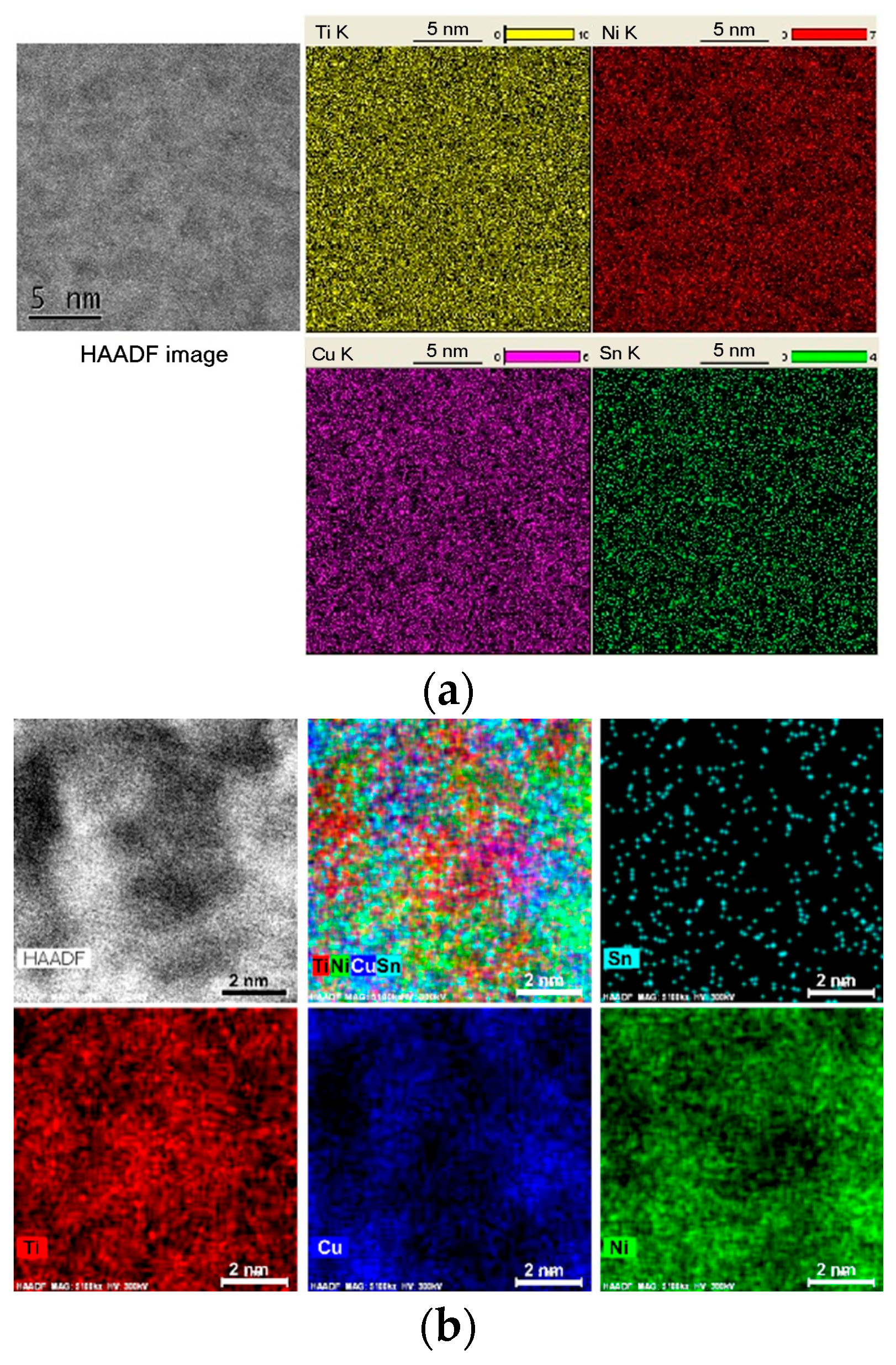
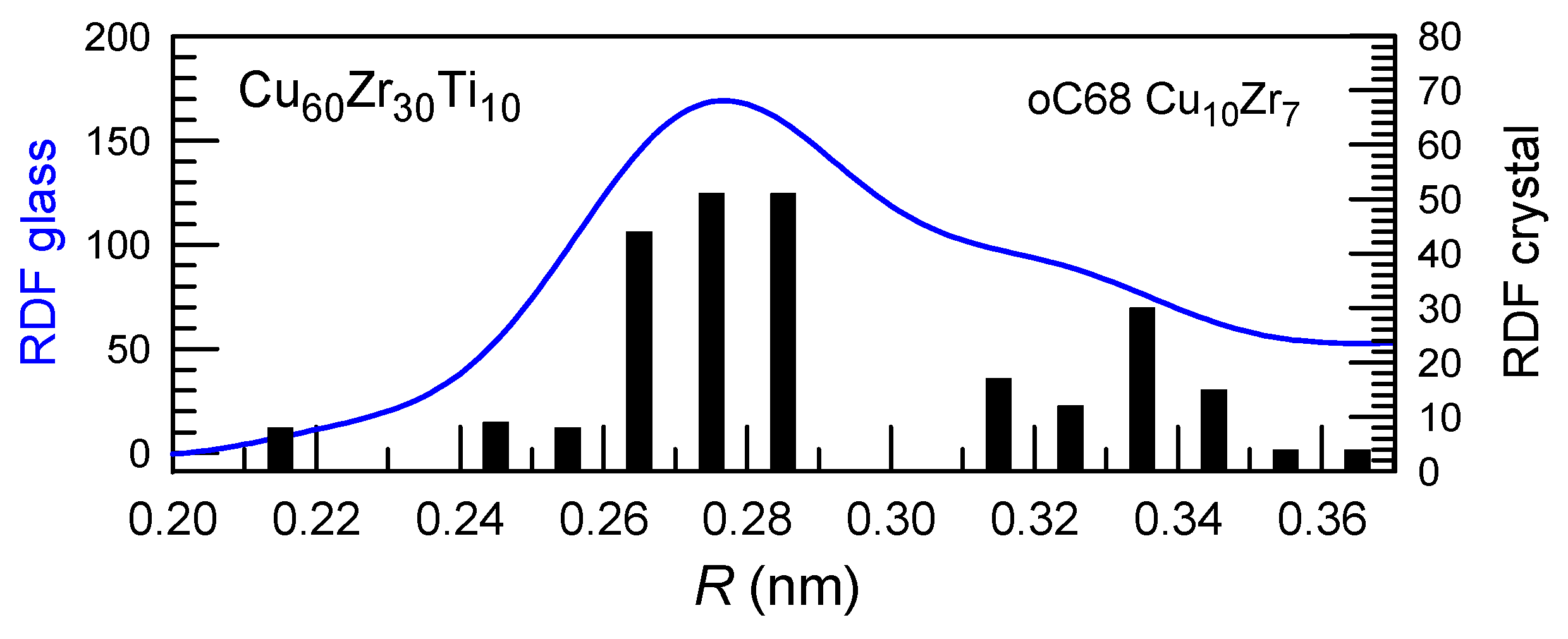
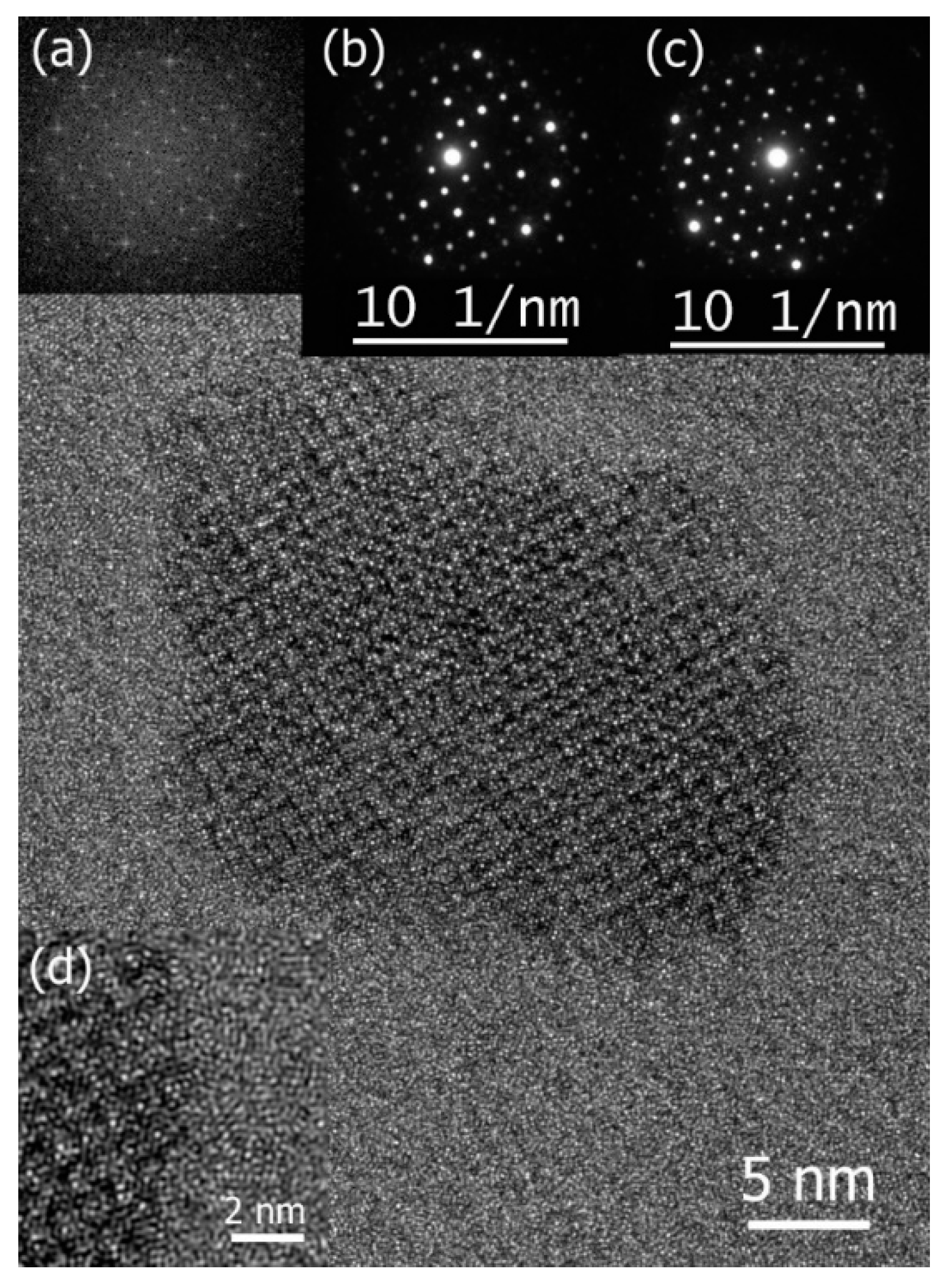
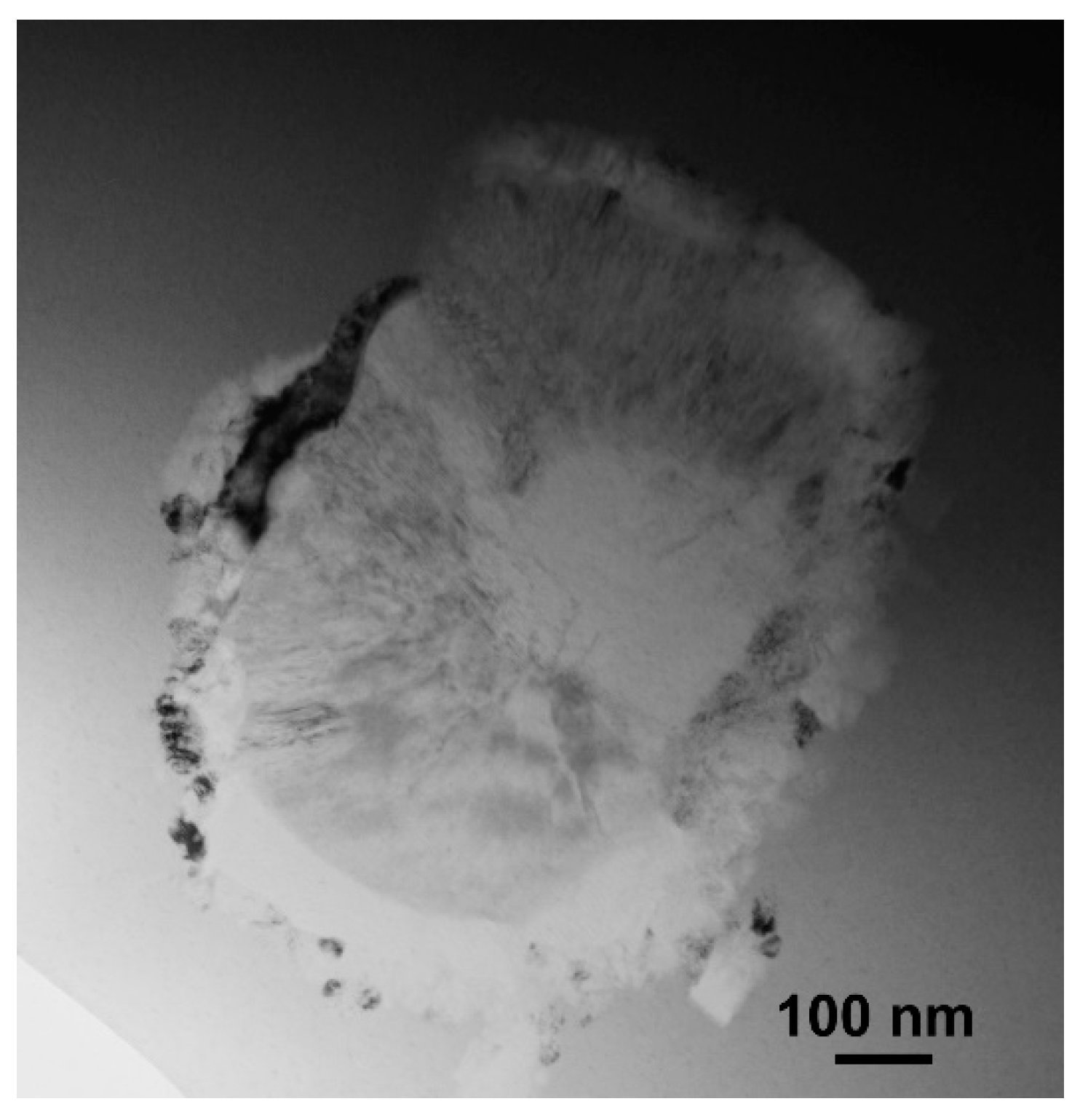
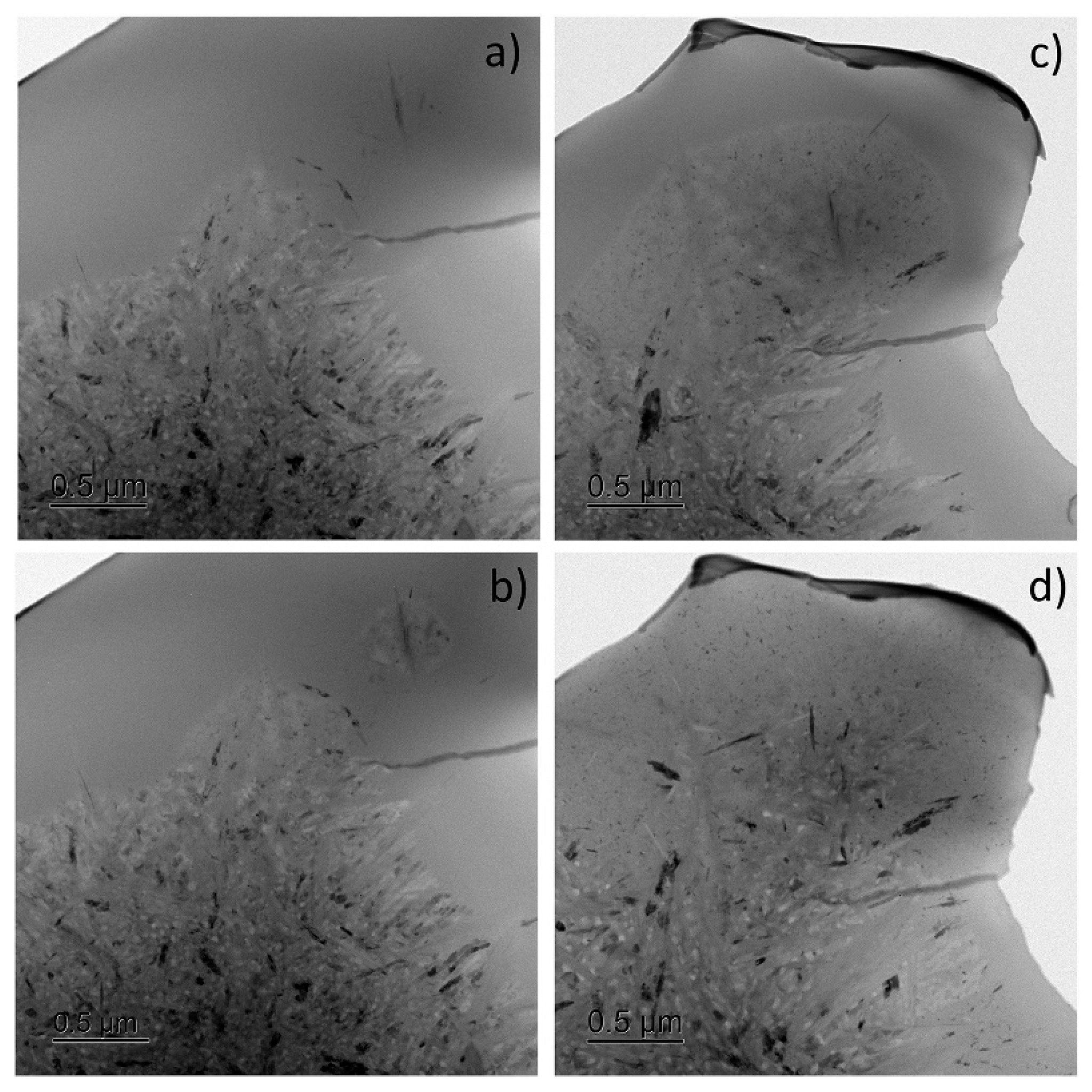


Disclaimer/Publisher’s Note: The statements, opinions and data contained in all publications are solely those of the individual author(s) and contributor(s) and not of MDPI and/or the editor(s). MDPI and/or the editor(s) disclaim responsibility for any injury to people or property resulting from any ideas, methods, instructions or products referred to in the content. |
© 2024 by the author. Licensee MDPI, Basel, Switzerland. This article is an open access article distributed under the terms and conditions of the Creative Commons Attribution (CC BY) license (https://creativecommons.org/licenses/by/4.0/).
Share and Cite
Louzguine-Luzgin, D.V. Crystallization of Metallic Glasses and Supercooled Liquids. Materials 2024, 17, 3573. https://doi.org/10.3390/ma17143573
Louzguine-Luzgin DV. Crystallization of Metallic Glasses and Supercooled Liquids. Materials. 2024; 17(14):3573. https://doi.org/10.3390/ma17143573
Chicago/Turabian StyleLouzguine-Luzgin, Dmitri V. 2024. "Crystallization of Metallic Glasses and Supercooled Liquids" Materials 17, no. 14: 3573. https://doi.org/10.3390/ma17143573
APA StyleLouzguine-Luzgin, D. V. (2024). Crystallization of Metallic Glasses and Supercooled Liquids. Materials, 17(14), 3573. https://doi.org/10.3390/ma17143573





